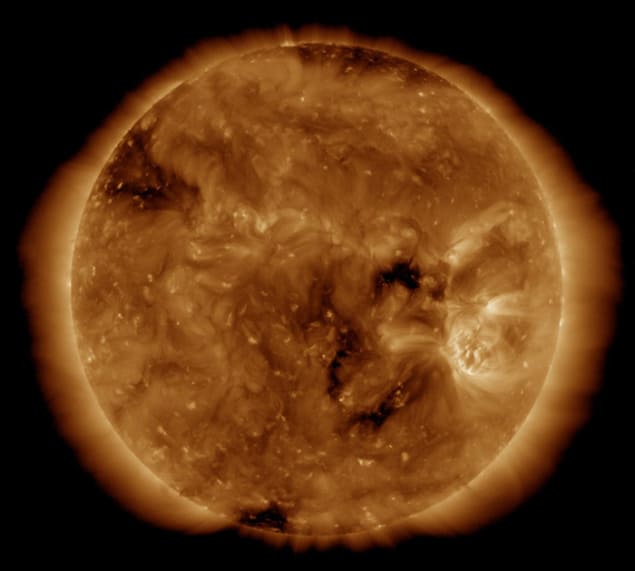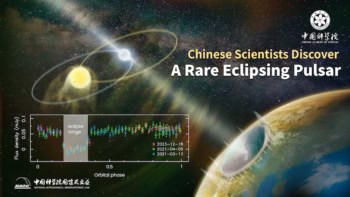
The Sun’s core rotates four times faster than its outer layers – and the elemental composition of its corona is linked to the 11 year cycle of solar magnetic activity. These two findings have been made by astronomers using a pair of orbiting solar telescopes – NASA’s Solar Dynamics Observatory (SDO) and the joint NASA–ESA Solar and Heliospheric Observatory (SOHO). The researchers believe their conclusions could revolutionize our understanding of the Sun’s structure.
Onboard SOHO is an instrument named GOLF (Global Oscillations at Low Frequencies) – designed to search for millimetre-sized gravity, or g-mode, oscillations on the Sun’s surface (the photosphere). Evidence for these g-modes has, however, proven elusive – convection of energy within the Sun disrupts the oscillations, and the Sun’s convective layer exists in its outer third. If solar g-modes exist then they do so deep within the Sun’s radiative core.
A team led by Eric Fossat of the Université Côte d’Azur in France has therefore taken a different tack. The researchers realized that acoustic pressure, or p-mode, oscillations that penetrate all the way through to the core – which Fossat dubs “solar music” – could be used as a probe for g-mode oscillations. Assessing over 16 years’ worth of observations by GOLF, Fossat’s team has found that p-modes passing through the solar core are modulated by the g-modes that reverberate there, slightly altering the spacing between the p-modes.
Fossat describes this discovery as “a fantastic result”, in terms of what g-modes can tell us about the solar interior. The properties of the g-mode oscillations depend strongly on the structure and conditions within the Sun’s core, including the ratio of hydrogen to helium, and the period of the g-modes indicate that the Sun’s core rotates approximately once per week. This is around four times faster than the Sun’s outer layers, which rotate once every 25 days at the equator and once every 35 days at the poles.
Diving into noise
Not everyone is convinced by the results. Jeff Kuhn of the University of Hawaii describes the findings as “interesting”, but warns that independent verification is required.
“Over the last 30 years there have been several claims for detecting g-modes, but none have been confirmed,” Kuhn told physicsworld.com. “In their defence, [Fossat’s researchers] have tried several different tests of the GOLF data that give them confidence, but they are diving far into the noise to extract this signal.” He thinks that long-term ground-based measurements of some p-mode frequencies should also contain the signal and confirm Fossat’s findings further.
If the results presented in Astronomy & Astrophysics can be verified, then Kuhn is excited about what a faster spinning core could mean for the Sun. “It could pose some trouble for our basic understanding of the solar interior,” he says. When stars are born, they are spinning fast but over time their stellar winds rob their outer layers of angular momentum, slowing them down. But Fossat suggests that conceivably their cores could somehow retain their original spin rate.
Solar links under scrutiny
Turning attention from the Sun’s core to its outer layers reveals another mystery. The energy generated by nuclear reactions in the Sun’s core ultimately powers the activity in the Sun’s outer layers, including the corona. But the corona is more than a million degrees hotter than the layers of the chromosphere and photosphere below it. The source of this coronal heating is unknown, but a new paper published in Nature Communications has found a link between the elemental composition of the corona, which features a broad spectrum of atomic nuclei including iron and neon, and the Sun’s 11 year cycle of magnetic activity.
Observations made by SDO between 2010 (when the Sun was near solar minimum) and 2014 (when its activity peaked) revealed that when at minimum, the corona’s composition is dominated by processes of the quiet Sun. However, when at maximum the corona’s composition is instead controlled by some unidentified process that takes place around the active regions of sunspots.
That the composition of the corona is not linked to a fixed property of the Sun (such as its rotation) but is instead connected to a variable property, could “prompt a new way of thinking about the coronal heating problem,” says David Brooks of George Mason University, USA, who is lead author on the paper. This is because the way in which elements are transported into the corona is thought to be closely related to how the corona is being heated.
Quest for consensus
Many explanations for the corona’s high temperature have been proposed, ranging from magnetic reconnection to fountain-like spicules, and magnetic Alfvén waves to nanoflares, but none have yet managed to win over a consensus of solar physicists.
“If there’s a model that explains everything – the origins of the solar wind, coronal heating and the observed preferential transport – then that would be a very strong candidate,” says Brooks. The discovery that the elemental abundances vary with the magnetic cycle is therefore a new diagnostic against which to test models of coronal heating.



